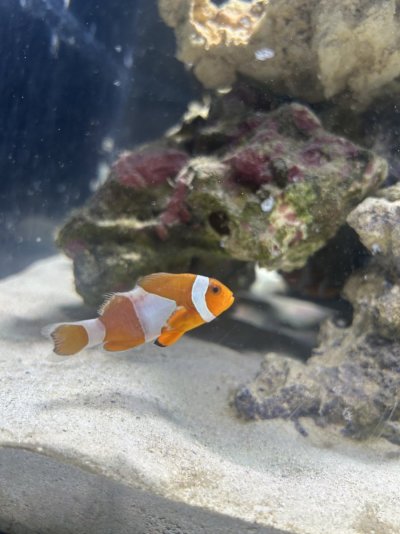tank has been setting for about 2 weeks. Tested all my levels and was ready for fish. Got 2 clown fish yesterday, finally got the lights back on this morning to get my first good look at the fish. Noticed the one clown has a few white dots near his head, what could this be? Hes still super active and looks to be doing well.
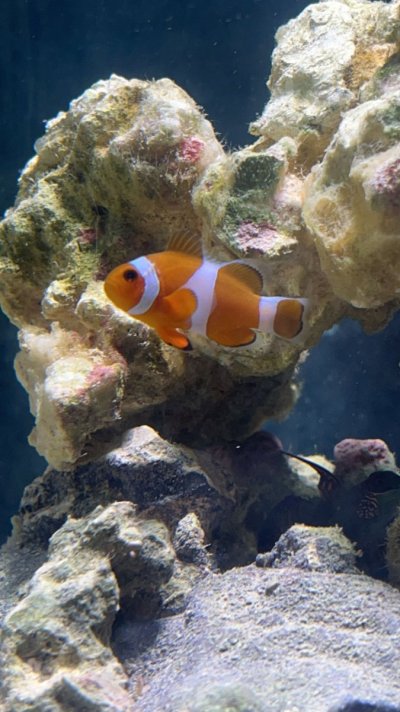
Any change in behavior? Is the fish still eating normally?
Could be an injury or the start of brook at a first glance.
BTW - I see a mandarin in the back. Those fish need large, very well established tanks to sustain their diet (which requires only live copepods).
Just got these 2 clown fish. I noticed the first one had a few white dots near his head. Is this anything to worry about? The second picture is the other clown, he just looks beat up or is this normal? PLEASE HELP!!
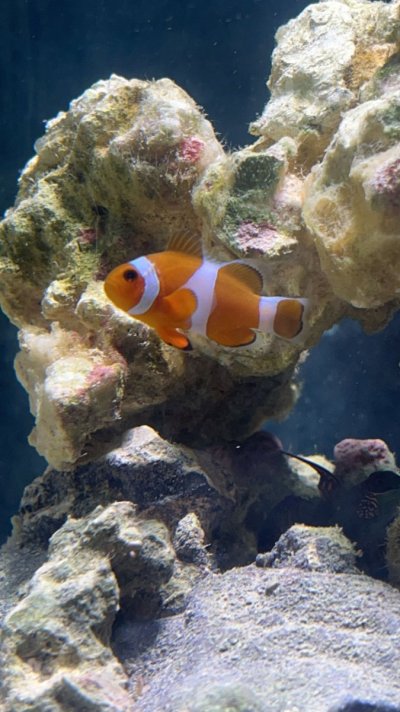
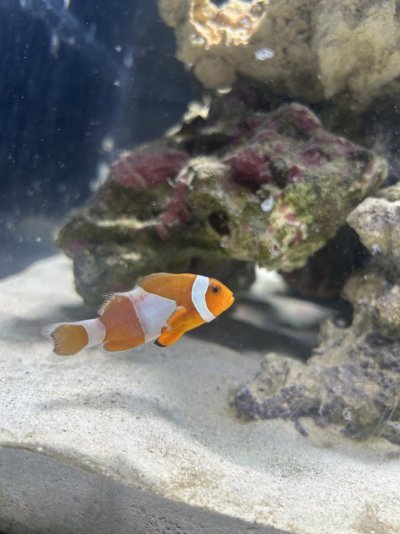
#fishmedic

 www.reef2reef.com
www.reef2reef.com
Bottom one definitely looks rough, possibly velvet. You’ll need to treat them in a hospital tank, read up on HumbleFish for directions/proper ID.
Did it look like that when you got it?
That clown looks very thin, beat up, and there appears to be a bacterial infection going on.
#fishmedic
Welcome to Reef2Reef!
That second picture would be a huge red flag not to buy that fish....the store should not have sold it to you if you missed the symptoms yourself. Huge sections of the clown's fins are missing and it has body injuries.
My concern is that the other clown, looking pretty strong and robust may be taking advantage of the situation and is striking out at this one when you aren't looking, making the situation even worse.
Jay
Not knowledgeable enough to fully diagnose non-human diseases, but second one definitely looks unhealthy. Brooklynella is more common in clownfish but they also can have velvet. Second one may also have secondary inbacterial infection from some prior aggression by other fish.
Are they breathing heavy? Is skin covered with slime? Short video would also help.
Treatment of brooklynella differs from velvet and treatment of bacterial infection is also different so hopefully one of fish medics will help you diagnose, but meanwhile I would assemble necessary tools: smalll hospital tank with internal filter and heater.
God luck!
Just got this guy from the pet shop, noticed these white dots on his head. Is it something to be worried about? Only been about 24 hrs in the tank so hes just been hiding.
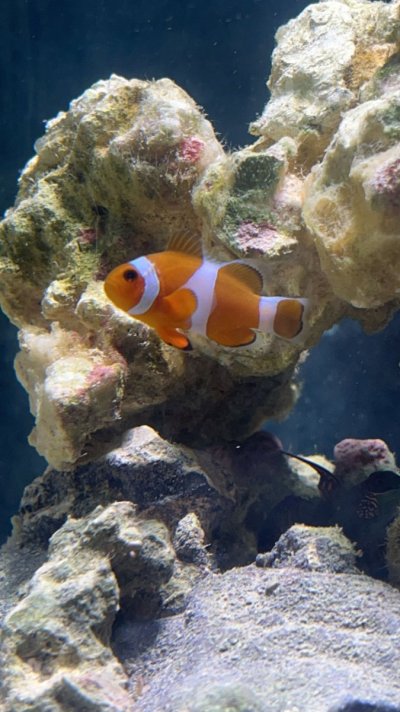
@Jay Hemdal
@vetteguy53081
generally starts at the facial area as well as gills and spreads across the body producing lesions as it progresses often confused with ich and can turn into secondary bacteria. Other symptoms will be lethargic behavior, refusing to eat and heavy breathing from the mucus.
Typical treatment is a formalin solution is mixed with in a separate container with either fresh or saltwater. Start with a quick dip in the formalin at a higher concentration then performing treatment in a prolonged bath of formalin base at a lower concentration in a quarantine tank. The longer the fish are exposed to the formalin treatment the more effective it will be at eliminating this issue.
If a formalin solution is not available for immediate use, temporary relief can be achieved by giving the fish a FW bath or dip in water same temperature as display tank. Even though this treatment will not cure the disease, it can help to remove some of the parasites, as well as reduce the amount of mucus in the gills to assist with respiration problems.
Treatment is best done in a QT tank using either quick cure (more effective but now harder to find) or Ruby Rally Pro. Ruby takes a little longer and initial treatment generally takes 2-3 days to really start going to work.
With the advanced stage of this- I recommend immediate quarantine of all inhabitants and leaving display without fish for 4-6 weeks.
A quarantine system if you dont have one can be as simple as a starter tank kit from walmart which has most of the essentials
That's Brook. Vetteguy posted solid advice on how to treat.
Folks - there are two threads discussing these same fish. That gets WAY too confusing for anyone to follow.
Jay
I did a 5min fresh water bath and then a 40min formalin bath for all fish before moving them to the HT.
Because your not sure what your dealing with (velvet or brook) I would probably dose both copperpower and metro in the HT just make sure you have air stones.

Any change in behavior? Is the fish still eating normally?
Could be an injury or the start of brook at a first glance.
BTW - I see a mandarin in the back. Those fish need large, very well established tanks to sustain their diet (which requires only live copepods).
I have a pods for him to eat, im going to be moving him over to the 50 gallon just threw him in the 25 gal till he gets a little bigger. As for the clowns they are doing good, swimming all around and eating.Any change in behavior? Is the fish still eating normally?
Could be an injury or the start of brook at a first glance.
BTW - I see a mandarin in the back. Those fish need large, very well established tanks to sustain their diet (which requires only live copepods).
Heres a picture of the other clown i got with him.Any change in behavior? Is the fish still eating normally?
Could be an injury or the start of brook at a first glance.
BTW - I see a mandarin in the back. Those fish need large, very well established tanks to sustain their diet (which requires only live copepods).
Just got these 2 clown fish. I noticed the first one had a few white dots near his head. Is this anything to worry about? The second picture is the other clown, he just looks beat up or is this normal? PLEASE HELP!!


#fishmedic

Some Helpful Hints When Posting or Responding to Threads in the Fish Disease Treatment and Diagnosis Section
Aquarium Fish Disease Problem Solving Determining the best course of action for a problem with your aquarium can be a difficult task. Even advanced aquarists will often need to seek the help of others for complicated or unique issues. Our intent here on Reef 2 Reef is to offer expert advice...
 www.reef2reef.com
www.reef2reef.com
Bottom one definitely looks rough, possibly velvet. You’ll need to treat them in a hospital tank, read up on HumbleFish for directions/proper ID.
Did it look like that when you got it?
That clown looks very thin, beat up, and there appears to be a bacterial infection going on.
#fishmedic
Yes looked like that from the store.Did it look like that when you got it?
That clown looks very thin, beat up, and there appears to be a bacterial infection going on.
#fishmedic
Yes looked like that from the store.
Welcome to Reef2Reef!
That second picture would be a huge red flag not to buy that fish....the store should not have sold it to you if you missed the symptoms yourself. Huge sections of the clown's fins are missing and it has body injuries.
My concern is that the other clown, looking pretty strong and robust may be taking advantage of the situation and is striking out at this one when you aren't looking, making the situation even worse.
Jay
Not knowledgeable enough to fully diagnose non-human diseases, but second one definitely looks unhealthy. Brooklynella is more common in clownfish but they also can have velvet. Second one may also have secondary inbacterial infection from some prior aggression by other fish.
Are they breathing heavy? Is skin covered with slime? Short video would also help.
Treatment of brooklynella differs from velvet and treatment of bacterial infection is also different so hopefully one of fish medics will help you diagnose, but meanwhile I would assemble necessary tools: smalll hospital tank with internal filter and heater.
God luck!
Just got this guy from the pet shop, noticed these white dots on his head. Is it something to be worried about? Only been about 24 hrs in the tank so hes just been hiding.

@Jay Hemdal
@vetteguy53081
This would be the first clown in the pictures took the other clown out of the tank and put in a small 5 gallonNot knowledgeable enough to fully diagnose non-human diseases, but second one definitely looks unhealthy. Brooklynella is more common in clownfish but they also can have velvet.
Are they breathing heavy? Is skin covered with slime? Short video would also help.
Treatment of brooklynella differs from velvet, so hopefully one of fish medics will help you diagnose, but meanwhile I would assemble necessary tools: smalll hospital tank with internal filter and heater. If they are very sick, freshwater dip can temporarily relieve symptoms. BTW-you need to treat all fish from this tank.
God luck!
Fish on left has bacterial lesions and one on right likely brooklynella which mainly affects wild caught clowns. This
generally starts at the facial area as well as gills and spreads across the body producing lesions as it progresses often confused with ich and can turn into secondary bacteria. Other symptoms will be lethargic behavior, refusing to eat and heavy breathing from the mucus.
Typical treatment is a formalin solution is mixed with in a separate container with either fresh or saltwater. Start with a quick dip in the formalin at a higher concentration then performing treatment in a prolonged bath of formalin base at a lower concentration in a quarantine tank. The longer the fish are exposed to the formalin treatment the more effective it will be at eliminating this issue.
If a formalin solution is not available for immediate use, temporary relief can be achieved by giving the fish a FW bath or dip in water same temperature as display tank. Even though this treatment will not cure the disease, it can help to remove some of the parasites, as well as reduce the amount of mucus in the gills to assist with respiration problems.
Treatment is best done in a QT tank using either quick cure (more effective but now harder to find) or Ruby Rally Pro. Ruby takes a little longer and initial treatment generally takes 2-3 days to really start going to work.
With the advanced stage of this- I recommend immediate quarantine of all inhabitants and leaving display without fish for 4-6 weeks.
A quarantine system if you dont have one can be as simple as a starter tank kit from walmart which has most of the essentials
That's Brook. Vetteguy posted solid advice on how to treat.
Your other post was answered. Please refrain from cross-posting as this is taking away from others seeking help with their issues
Why is Humblefish forum being brought to R2R? This presents confusion to the poster as there is often conflicting information and when things go wrong, finger pointing begins and ends with blame on all parties.That's Brook. Here's a link to humblefish for treatment guide:
Brooklynella
Brooklynella hostilis (updated 6-9-2023) What You Need To Know: * This is most often seen with clownfish, but it can afflict other fish (usually in the gills) as well. When a clownfish has Brook, the skin will appear to be peeling or sloughing off. Which is actually excess white mucous coming...humble.fish
Folks - there are two threads discussing these same fish. That gets WAY too confusing for anyone to follow.
Jay
Fair enough. I didn't take that into consideration and apologize. Still feeling my way around here. Post edited to remove link.Why is Humblefish forum being brought to R2R? This presents confusion to the poster as there is often conflicting information and when things go wrong, finger pointing begins and ends with blame on all parties.
Going to move them all to a hospital tank and do these steps. Is a water change necessary on my main tank? Thank you for the help!Fish on left has bacterial lesions and one on right likely brooklynella which mainly affects wild caught clowns. This
generally starts at the facial area as well as gills and spreads across the body producing lesions as it progresses often confused with ich and can turn into secondary bacteria. Other symptoms will be lethargic behavior, refusing to eat and heavy breathing from the mucus.
Typical treatment is a formalin solution is mixed with in a separate container with either fresh or saltwater. Start with a quick dip in the formalin at a higher concentration then performing treatment in a prolonged bath of formalin base at a lower concentration in a quarantine tank. The longer the fish are exposed to the formalin treatment the more effective it will be at eliminating this issue.
If a formalin solution is not available for immediate use, temporary relief can be achieved by giving the fish a FW bath or dip in water same temperature as display tank. Even though this treatment will not cure the disease, it can help to remove some of the parasites, as well as reduce the amount of mucus in the gills to assist with respiration problems.
Treatment is best done in a QT tank using either quick cure (more effective but now harder to find) or Ruby Rally Pro. Ruby takes a little longer and initial treatment generally takes 2-3 days to really start going to work.
With the advanced stage of this- I recommend immediate quarantine of all inhabitants and leaving display without fish for 4-6 weeks.
A quarantine system if you dont have one can be as simple as a starter tank kit from walmart which has most of the essentials
Going to move them all to a hospital tank and do these steps. Is a water change necessary on my main tank? Thank you for the help!
Should i do a water change on my main tank too?Fish on left has bacterial lesions and one on right likely brooklynella which mainly affects wild caught clowns. This
generally starts at the facial area as well as gills and spreads across the body producing lesions as it progresses often confused with ich and can turn into secondary bacteria. Other symptoms will be lethargic behavior, refusing to eat and heavy breathing from the mucus.
Typical treatment is a formalin solution is mixed with in a separate container with either fresh or saltwater. Start with a quick dip in the formalin at a higher concentration then performing treatment in a prolonged bath of formalin base at a lower concentration in a quarantine tank. The longer the fish are exposed to the formalin treatment the more effective it will be at eliminating this issue.
If a formalin solution is not available for immediate use, temporary relief can be achieved by giving the fish a FW bath or dip in water same temperature as display tank. Even though this treatment will not cure the disease, it can help to remove some of the parasites, as well as reduce the amount of mucus in the gills to assist with respiration problems.
Treatment is best done in a QT tank using either quick cure (more effective but now harder to find) or Ruby Rally Pro. Ruby takes a little longer and initial treatment generally takes 2-3 days to really start going to work.
With the advanced stage of this- I recommend immediate quarantine of all inhabitants and leaving display without fish for 4-6 weeks.
A quarantine system if you dont have one can be as simple as a starter tank kit from walmart which has most of the essentials
Hey I just went through this exact situation.Should i do a water change on my main tank too?
I did a 5min fresh water bath and then a 40min formalin bath for all fish before moving them to the HT.
Because your not sure what your dealing with (velvet or brook) I would probably dose both copperpower and metro in the HT just make sure you have air stones.
While it wouldnt hurt, you're gonna need to run your main tank fallow for the next six weeks. So, IMO it really isn't necessary at this point. I would do one at the conclusion of the fallow period before reintroducing the fish to the DT.Should i do a water change on my main tank too?



